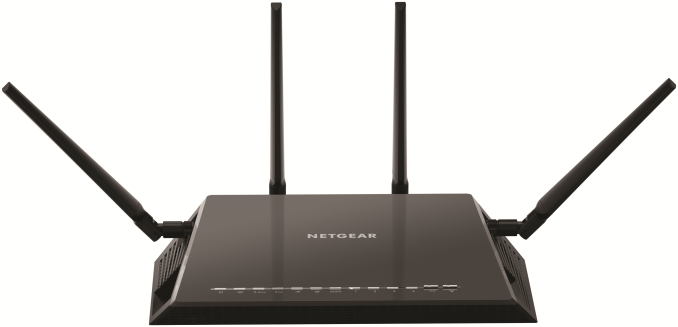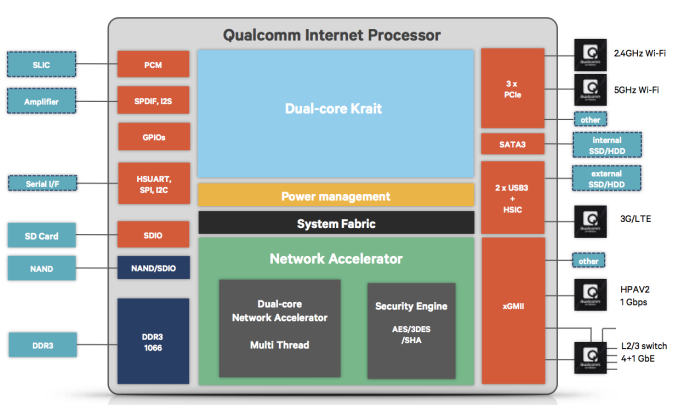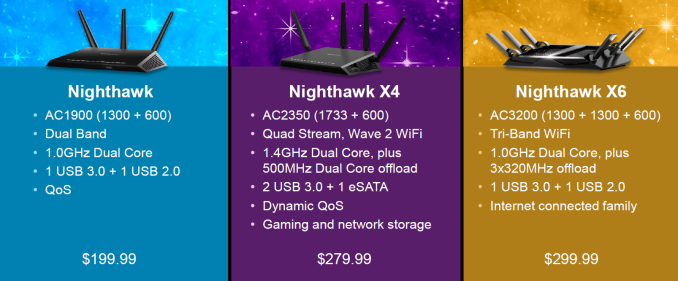Netgear R7500 Nighthawk X4 Integrates Quantenna 4x4 ac Radio and Qualcomm IPQ8064 SoC
by Ganesh T S on September 2, 2014 8:30 AM EST- Posted in
- Networking
- NetGear
- Wi-Fi
- Qualcomm Atheros
- Quantenna

The high-end 802.11ac router market has seen two introductions in the recent past. The first was the Netgear Nighthawk X6 which was based on the Broadcom 5G Wi-Fi XStream platform with two discrete 3x3 802.11ac radios. On the other side, we had Asus introduce the first Wave 2 router in the RT-AC87 using the same Broadcom SoC and 2.4 GHz radios as the Nighthawk X6, but choosing the Quantenna Wave 2 solution for the 5 GHz band. In the launch coverage of the RT-AC87, we had mentioned the online leaks of the Netgear Nighthawk X4 router. Today, Netgear is providing us the official details.
In terms of the configuration of the radios, the Netgear Nighthawk X4 and the Asus RT-AC87 are equivalent. Both of them belong to the AC2350 / AC2400 class, i.e, four 5 GHz (802.11ac) radios (4x 433 Mbps) and three 2.4 GHz (802.11n) radios (3x 200 Mbps) for a net aggregate of 2.333 Gbps. We have already touched upon all the advantages of the Quantenna Wave 2 solution over the current solutions from Broadcom and Qualcomm Atheros. In essence, the 4x4 update (quad-stream Wi-Fi) provides faster Wi-Fi throughput, enables more stable and jitter-free video streaming and provides more robust Wi-Fi connection for a larger number of devices.
There are two internal hardware aspects in which the Nighthawk X4 differs from the Asus RT-AC87:
- Platform SoC (Qualcomm Internet Processor IPQ8064 instead of the Broadcom BCM4709A)
- Interface between the 5 GHz radios and the platform SoC (PCIe instead of RGMII)
Due to the difference in the platform SoC, the external I/O is also different. While the Asus RT-AC87 had a USB 2.0 port and a USB 3.0 port, the Netgear R7500 Nighthawk X4 has two USB 3.0 ports and an eSATA port. The IPQ8064 SoC has two Krait cores running at 1.4 GHz (compared to the two Cortex-A9s running at 1 GHz in the BCM4709A).
While the IPQ8604 does have GMII interfaces, Netgear decided to use the PCIe ports to make sure that they were able to make full use of the radio's capabilities to go beyond 1 Gbps in each direction. The radios also have offloading processors running at 500 MHz to enable the main SoC to devote CPU cycles for other functions (storage, VPN etc.)
Coming back to the R7500, Netgear touts dynamic QoS as one of the main features. The router has a list of devices / apps (which can be updated independent of the firmware) which enables allocation of bandwidth based on the application. The goal is to ensure that latency sensitive apps get the highest priority while also making sure that the lowest priority apps don't get choked off. Netgear also claims to have put in special hooks for video streaming sites to prevent buffering while accessing adaptive bitrate sites (such as Netflix) at the same time as the non-adaptive ones (such as YouTube). Plans are also in-place to support the R7500 on myopenrouter.com.
Netgear plans to carry all three Nighthawk versions in the market for now, as they target different segments. The positioning and key points of the three members are reproduced in the slide below.
The R7500 Nighthawk X4 is priced at $280 which closely tracks the Asus RT-AC87 pricing. It will be an interesting tussle in the market between the two, as Asus will also bring the Broadcom XStream solution demonstrated at Computex to the market soon.















10 Comments
View All Comments
icrf - Tuesday, September 2, 2014 - link
So does the faster SoC along with offloading mean this will route a full gigabit per second? I ask because my fiber doesn't terminate where I'd like to put a real server capable of doing that kind of routing (I know, the horror!) :Pcode65536 - Wednesday, September 3, 2014 - link
Um, many consumer-grade routers are already capable of gigabit routing; see the reviews on SmallNetBuilder.com. (However, this requires the stock firmware as it involves using proprietary code that bypasses the rather heavy Linux netfilter. DD-WRT is currently testing their own open-source re-implementation of this accelerated routing, but it's currently buggy.)icrf - Wednesday, September 3, 2014 - link
SmallNetBuilder's throughput tests aren't very meaningful. Yes, that is peak throughput, but if you have normal clients connected, or want to run firewall rules of any kind, speed drops way, way down. A friend of mine bought one that they claimed would do 950 Mbps, but he saw maybe half that. Jacked in directly, bypassing the router, he got the full gigabit.http://www.smallnetbuilder.com/lanwan/lanwan-howto...
icrf - Thursday, September 4, 2014 - link
For example, the R7000, SmallNetBuilder says is good for 930-940 Mbps [1]. DDWRT says that with stock firmware (ie, not actually running DDWRT), it's good for 450 Mbps [2], which is what my friend is seeing (with DDWRT, 360 Mbps, which is the proprietary hardware you mentioned).I don't know quite all the detail of what they're doing, but they're turning everything off and tuning everything to get best case scenario throughput that no one in actual normal use will see. It's disappointing there isn't a better resource for real work throughput testing. I guess there just aren't enough people who actually need it.
[1] http://www.smallnetbuilder.com/wireless/wireless-r...
[2] http://dd-wrt.com/wiki/index.php/DD-WRT_on_R7000
DuckieHo - Tuesday, September 2, 2014 - link
No MU-MIMO yet, right?Betak - Tuesday, September 2, 2014 - link
According to smallnetbuilder.com: "If you're looking for MU-MIMO support, you're also out of luck. NETGEAR said that the R7500 will not support Multi-User MIMO when shipments begin, but it will be added via a future firmware upgrade."edlee - Tuesday, September 2, 2014 - link
This router has a better cpu that midrange smartphones, sans the gpu and communications chip.A5 - Tuesday, September 2, 2014 - link
It probably does a lot more work on a day-to-day basis than a mid-range smartphone too :Pp3ngwin1 - Tuesday, September 2, 2014 - link
and the power consumption difference o.Obrown7228 - Sunday, June 7, 2015 - link
I have lousy internet service they advertize 6Mbps but at peak time its as slow as .78mbps. I can't even use my internet phone nevermind netflix. Will any of these new routes help?